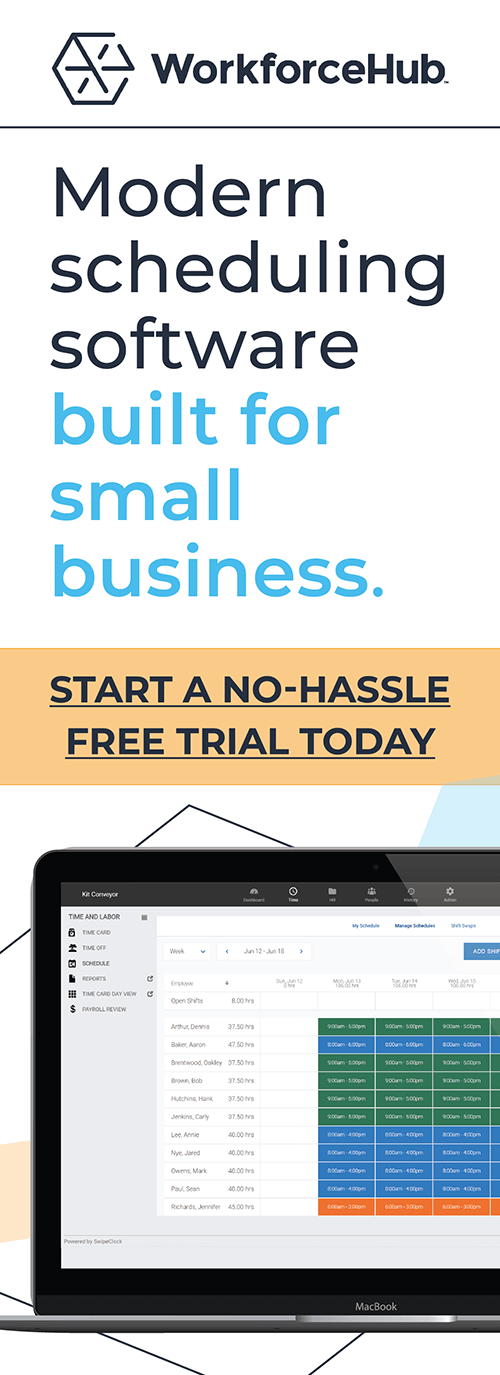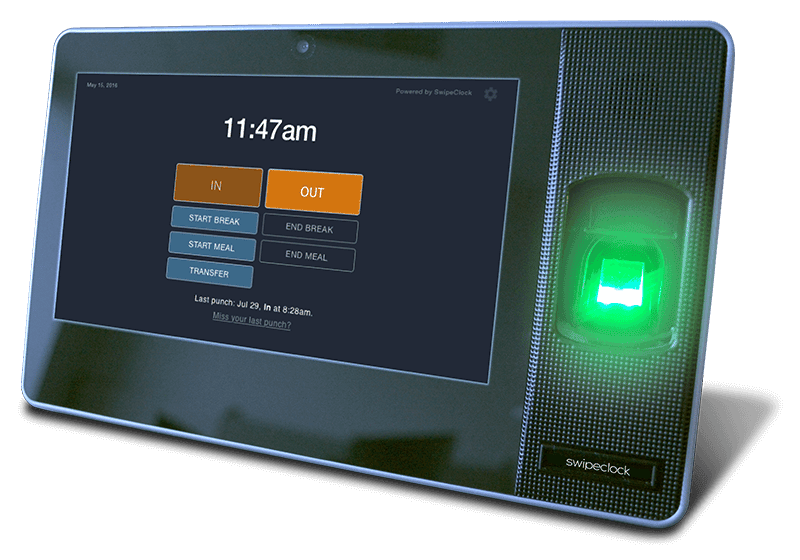New Time Tracking Software Could Transform Your Business in 2018

If you are a business owner still using a manual employee time and attendance system or outdated time clock software, this article contains important information for you. Upgrading to a Workforce Management system with the latest tools and technology could be the smartest decision you make all year.
Outdated Time Tracking Software is Putting You in a World of Hurt
Outdated timekeeping systems fall short for a number of reasons. They don’t protect you from employee time theft. There are no tools for staying compliant with labor regulations. Scheduling confusion is a constant problem and they often require tedious manual data entry. If you are dealing with these problems, your system is probably prohibiting growth and stifling innovation in your organization.
Perhaps you are using pen and paper timesheets at a coffee shop or a punch clock at a roofing company. Maybe you are relying on spreadsheets at a day spa or an outdated automated system at a cabinet shop. Whatever your situation, you are forgoing key benefits that could transform every level of your organization.
If you are a small business owner still using outdated Workforce Management systems, you may not even realize all the ways your system is holding you back.
The Problems With Outdated Employee Time and Attendance
1. Outdated Time Clock Software Doesn’t Protect You From Employee Time Theft
It’s important for all employers—especially new business owners in the process of securing funding and planning their budgets—to understand that employee time theft is common in most industries. Whether you own a temp agency, convalescent home, or fleet of catering trucks, odds are that you pay workers for time they didn’t actually work.
Many employers who give up their manual timekeeping systems and implement an automated system such as SwipeClock Workforce Management Suite experience a drop in payroll hours. This is an indication that some employees were either intentionally fudging their time cards, failing to clock out for unpaid breaks, or buddy punching for an absent or late co-worker. Are you curious about which employees are repeat offenders at your company?
2. Outdated Time Tracking Software Doesn’t Provide an Easy Way to Trade Shifts
Streamlined shift-trading processes are a win-win. They help you by preventing coverage gaps and allow your employees to juggle competing priorities. Employees rely on shift-trading to cover a shift when they have a sudden family issue or pick up an open shift when they need more hours. Workers who can trade shifts without a major hassle are more likely to stay at your company. It’s also no surprise that grateful employees are more focused and more productive. Positive vibes lead to lower employee turnover and a much more pleasant workplace.
The problem is using tools and processes that don’t handle shift trades efficiently. It really shouldn’t require several texts, phone calls, emails, or notes on a whiteboard exchanged between all the players. This includes the employee who needs a shift covered, the workers who are able to take the open shift, and the supervisor who needs to approve the swap. Ironically, this is the shift-trading mess at many businesses that have otherwise automated operations.
Workforce Management Suite has a Virtual Trade Board that serves as a centralized online exchange for employee shift trading. Employees can post shifts they need covered and view open shifts available. Supervisors can approve trades in real time. The system allows you to set rules according to your company’s shift trade policies. Using the Virtual Trade Board is a game changer in terms of efficiency and employee satisfaction. It allows managers to accommodate employees who need a lighter schedule as well as team members who want to pick up extra hours. No mind-reading required with an online exchange board that all parties can access 24/7/365.
3. Outdated Time and Attendance Puts You at Risk of Compliance Violations
How do manual time and attendance systems increase your risk of wage hour violations? It’s simple, they fail to accurately track employee hours and schedules. Accurate data is essential for complying with regulations and validating your compliance in the case of an audit or legal action.
If you have been laissez-faire about your compliance procedures or just too busy to deal with it right now, it’s understandable. Let technology ease this sketchy situation to protect you from hefty penalties that could sink your company. It’s not just big employers who are on the DOL’s radar; small employers in all industries are just as likely to be investigated.
If you are an employer still using a manual time and attendance system and have a sense of security regarding labor compliance, we suggest you visit the DOL press release webpage. Here are some recent cases that may convince you that your sense of security is misplaced. All of these were listed on the site the day this blog post was written. (Emphasis added by the author of this article.)
“Fabulous Freddie’s Italian Eatery, a restaurant in Chicago’s South Loop, and one of its owners, have paid 58 employees a total of $339,418 in unpaid wages and damages in a consent judgment following a U.S. Department of Labor Wage and Hour Division investigation. Division investigators found the restaurant and owner failed to comply with the Fair Labor Standards Act’s (FLSA) minimum wage, overtime, and recording-keeping provisions.”
“A gas station group and two check-cashing businesses have paid $88,712 in back wages to 39 employees after U.S. Department of Labor Wage and Hour Division investigations found violations of the minimum wage, overtime, and recordkeeping requirements of the Fair Labor Standards Act (FLSA).”
A U.S. Department of Labor Wage and Hour Division investigation into an Alpharetta-based furniture installer, determined the company violated the Fair Labor Standards Act (FLSA), and owed employees $194,069. R.I.O.F Inc. – which provides labor for furniture dealers and other furniture installation businesses –misclassified 109 employees as independent contractors and failed to pay overtime.”
4. Outdated Employee Timekeeping Processes Take Too Much Admin Time
If necessity is the mother of invention, then inefficiency must be the mother of frustration. If your business is large enough that you have an HR manager or department, you might not realize how much time it is taking him/her/them to run payroll. They have to gather time cards, manually enter data, track accruals, and respond to employee requests for information. If your time and attendance system is not synced with your payroll system, it adds another layer of tedium and opportunity for human error. If your HR manager is often harried and unhappy, this could well be the reason. By the way, if you are the harried HR manager, welcome to the SwipeClock blog. We invite you to use this article to persuade your boss to schedule a demo of SwipeClock’s Workforce Management Suite.
5. Outdated Employee Time and Attendance Systems Don’t Capture Data for Analysis
Small business owners who want to take their business to the next level need concrete numbers on which to base decisions. Employee management isn’t always the first thing a small business owner looks at when trying to expand, but maybe it should be. As a small business owner, labor is your biggest expense. (We make this point quite often, but believe that it bears repetition.)
Making strategic changes in shift staffing based on accurate historical data can have a big impact on productivity. It can also improve the customer experience along with employee morale. Employee time and labor data that is automatically captured grows into a mother lode for data mining. Identifying which employee often clocks in fifteen minutes late is valuable information, especially if he is the one that has to take those early customer calls from the East Coast. Discovering that your swing shift manufacturing crew is 10% more productive than your graveyard shift can help you make changes to increase productivity on all shifts.
What is the State-of-the-Industry for Workforce Management?
Now that I have reviewed the problems with substandard systems, let me describe the latest technology available. Namely, SwipeClock Workforce Management Suite paired with a scanning time clock. Workforce Management Suite consists of TimeWorksPlus for employee time and attendance and TimeSimplicity for employee scheduling. There is also a mobile app that allows your employees and managers to access the systems from any internet-enabled device (subject to your company’s access rules, of course). These components are cloud-based which means that you don’t store the software on your company hardware. You will never have to pay for updates or hire someone to come fix your software. Workforce Management Suite integrates seamlessly with your payroll system so no manual data entry is required to process payroll.
Here are some of the most popular system tools and the benefits they provide. If you are unfamiliar with automated Workforce Management, I suggest that you analyze them one by one in light of the operations at your company.
- Employees can punch in with a scanning time clock or online portal
- Automatic to-the-minute capture of employee punch in/out
- PunchLogic “employee aware” time clock only presents valid actions when employees punch in/out for shift start and end, meals, and breaks
- Employee hours are automatically tracked and recorded
- Customizable SMS or email overtime alerts allow you to manage overtime for all employees and shifts
- Schedule enforcement prevents early punch ins, late punch outs, or any unauthorized punches per company rules
- Mobile app uses pinpoint GPS to verify the location of remote punches
- Customizable job codes ensure that each shift is covered by the staff members with the necessary skills and/or certifications
- Virtual Trade Board streamlines shift trades and eliminates shift coverage gaps
- Copy-and-paste schedule templates and drag-and-drop schedule tools makes scheduling easy for multiple teams and/or locations
Because Workforce Management Suite has dedicated industry-specific tools, it is used in a variety of businesses. These include retail, food and beverage, manufacturing, healthcare, hospitality, and education.
Upgrading to SwipeClock Workforce Management Suite could be the smartest decision you make all year.
by Liz Strikwerda
Simplify HR management today.
Simplify HR management today.
The Importance of Facial Recognition Time Clocks for Small Businesses
Updated April 17, 2024 A facial recognition time clock is no longer a luxury. Advanced biometric clocks are a must-have for today’s workplaces. A facial recognition time clock is the best technology for tracking employee time. It solves a multitude of problems employers are facing with their workforces. What is a Facial Recognition Time Clock?…
Read MoreEmployee Time Clock Hardware: Which is the Best?
Updated April 9, 2024 What is employee time clock hardware? An employee time clock is a hardware device for tracking work time. To use it, employees ‘punch’ in/out or ‘clock’ in/out. The term ‘punch in’ stems from early employee time clock hardware that required a physical card. With a traditional mechanical time clock, the process…
Read More





